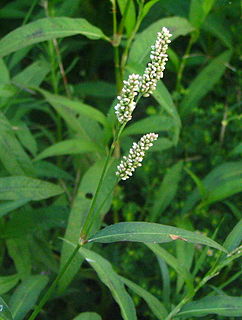
Polygonum is a genus of about 130 species of flowering plant in the buckwheat and knotweed family Polygonaceae. Common names include knotweed and knotgrass. In the Middle English glossary of herbs Alphita, it was known as ars-smerte. There have been various opinions about how broadly the genus should be defined. For example, buckwheat has sometimes been included in the genus as Polygonum fagopyrum. Former genera such as Polygonella have been subsumed into Polygonum; other genera have been split off.

Fallopia is a genus of about 12 species of flowering plants in the buckwheat family, often included in a wider treatment of the related genus Polygonum in the past, and previously including Reynoutria. The genus is native to temperate and subtropical regions of the Northern Hemisphere, but species have been introduced elsewhere. The genus includes species forming vines and shrubs.

Picea engelmannii, with common names Engelmann spruce, white spruce, mountain spruce, or silver spruce, is a species of spruce native to western North America, from central British Columbia and southwest Alberta, southwest to northern California and southeast to Arizona and New Mexico; there are also two isolated populations in northern Mexico. It is mostly a high altitude mountain tree, growing at 900 metres (3,000 ft) – 3,650 metres (11,980 ft) altitude, rarely lower in the northwest of the range; in many areas it reaches the alpine tree line.
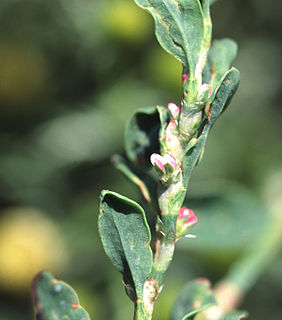
Polygonum arenastrum, commonly known as equal-leaved knotgrass, is a summer annual flowering plant in the knotweed family Polygonaceae. It is native to Europe and can be found on other continents as an introduced species and a common noxious weed. Other common names include common knotweed, prostrate knotweed, mat grass, oval-leaf knotweed, stone grass, wiregrass, and door weed, as well as many others, knotweed was first seen in North America in 1809 and is now seen across much of the United States and Canada.

Quercus engelmannii, the Engelmann oak or Pasadena oak, is a species of oak in the white oak section, native to southern California and northwestern Baja California, Mexico.

Eucephalus engelmannii is a North American species in the aster family known by the common name Engelmann's aster. It is native to the United States and Canada from Alberta and British Columbia to far northern California and Colorado.
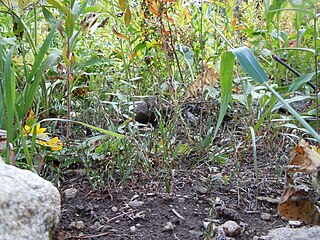
Polygonum douglasii is a species of flowering plant in the knotweed family known by the common name Douglas's knotweed. It is native to much of northern and western North America, where it can be found in many types of habitat, including disturbed areas. It has been found in Canada from British Columbia north to Yukon and east as far as Québec, and in the United States as far south as California, New Mexico, Iowa, and New York.
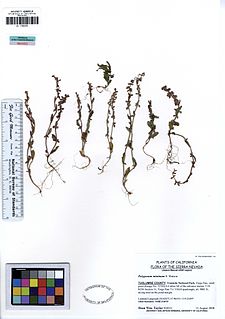
Polygonum minimum is a species of flowering plant in the knotweed family known by the common name broadleaf knotweed. It is native to much of western North America where it can be found in mountainous regions. It grows in the subalpine and alpine climates of high mountain ranges from Alaska to Arizona and New Mexico.
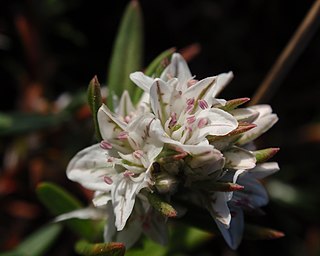
Polygonum paronychia is a species of flowering plant in the knotweed family known by the common names dune knotweed, black knotweed, and beach knotweed. It is native to the coastline of western North America from British Columbia to California, where it grows in sandy coastal habitat such as beaches, dunes, and scrub.
Polygonum parryi is a species of flowering plant in the knotweed family known by the common names Parry's knotweed and prickly knotweed. It is native to the western United States from Washington to California, where it grows in several types of moist, open habitat in mountainous and coastal areas.

Polygonum polygaloides is a North American species of flowering plants in the buckwheat family known by the common names milkwort knotweed and polygala knotweed. It is native to much of western North America, where it can be found in many types of moist habitat. It is a variable species, usually divided into a number of subspecies.

Bistorta bistortoides is a perennial herb in the buckwheat and knotweed family Polygonaceae. The species name remains unresolved.
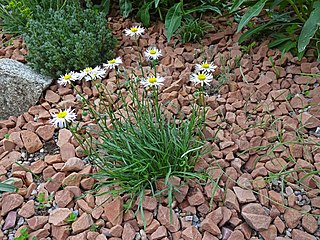
Erigeron engelmannii is a North American species of flowering plants in the daisy family known by the common name Engelmann’s fleabane.
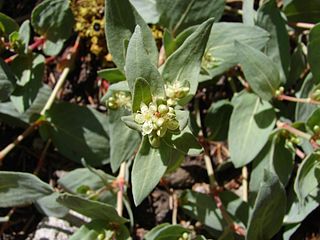
Koenigia davisiae is a flowering plant in the knotweed family that is known by the common names Davis' knotweed or Newberry knotweed.

Polygonum achoreum, common names Blake's knotweed, leathery knotweed or striate knotweed, is a North American species of plants in the buckwheat family. It is widespread across much of Canada and the northern United States.

Polygonum argyrocoleon, common names silver-sheath knotweed and Persian knotweed, is an Asian species of plants in the buckwheat family. It is native to Siberia, western China, Central Asia, and the Middle East. It has also become naturalized in parts of the United States, primarily the Southwest, and northwestern Mexico.
Polygonum austiniae, common name Mrs. Austin's knotweed, is a plant species in the buckwheat family. It is native to western Canada and the western United States, from Alberta and British Columbia south as far as California, Nevada, and Wyoming.
Polygonum majus is a North American species of flowering plant in the buckwheat family known by the common name wiry knotweed. It grows in the western United States and western Canada, from British Columbia south as far as the Sierra Nevada of northwestern Inyo County in California, east as far as Montana.
Polygonum spergulariiforme is a North American species of flowering plants in the buckwheat family known by the common name spurry knotweed or fall knotweed. It grows in western Canada and the western United States.
